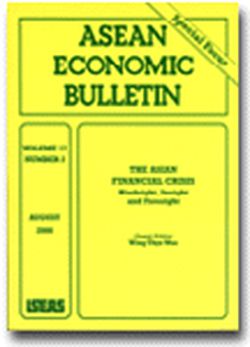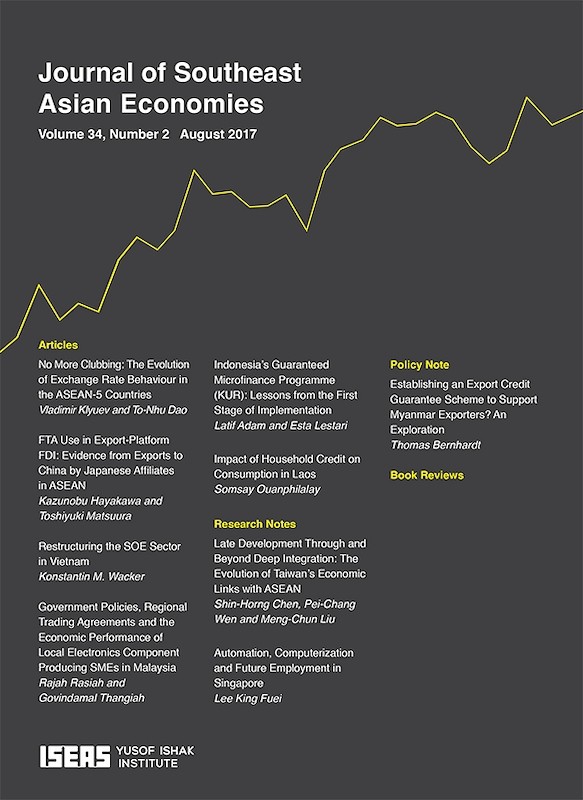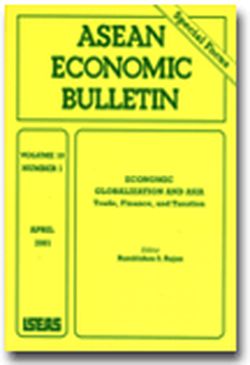ASEAN Economic Bulletin Vol. 17/2 (Aug 2000). Special Focus on "The Asian Financial Crisis: Hindsight, Insight, Foresight"

About the publication
Based on papers presented at a Conference on International Financial
Arrangements and the Asian Crisis, sponsored by the East-West Center,
Honolulu, Hawai'i.
Arrangements and the Asian Crisis, sponsored by the East-West Center,
Honolulu, Hawai'i.
Contents
-
Preliminary pages
-
The Asian Financial Crisis: Hindsight, Insight, Foresight, by Wing Thye Woo, author see abstractIntroduction to the Special Focus Issue of ASEAN Economic Bulletin Vol. 17, No. 2 (August 2000)
-
The Unorthodox Origins of the Asian Currency Crisis: Evidence from Logit Estimation, by Wing Thye Woo, Brian P Rosario, Patrick D Carleton, authors see abstractPicking the top five competitors in each of the ten top exports of Indonesia, Malaysia, the Philippines, South Korea and Thailand, we constructed a competitor and product weighted real exchange rate index for each country. Because these countries tied their currencies closely to the U.S. dollar, their real exchange rates appreciated substantially with the devaluation of the yuan (1990-94) and the yen (1995-96) against the U.S. dollar. But since there was no region-wide deterioration in the current account, they were unlikely to be the cause of the currency collapses. A fundamentals-based logit model of currency collapse fitted the pooled date of 57 countries satisfactorily. It was unable to predict (out-of-sample) the 1997 Asian financial crisis, suggesting that financial contagion rather than weak fundamentals is the more plausible explanation for the crisis.
-
Implications of the Malaysian Experience on Future International Financial Arrangements, by Mahani Zainal Abidin, author see abstractAt the onset of the East Asian crisis, Malaysia adopted policies similar to the other crisis-hit economies, tightening monetary and fiscal policies and floating the exchange rate, but the situation continued to deteriorate. In September 1998, Malaysia implemented selective capital controls to peg the ringgit to the U.S. dollar and restrict short-term capital flows. The controls gave Malaysia monetary policy independence to reflate the economy, and the breathing space to drastically restructure the financial and corporate sectors. The cost of the capital controls is that Malaysia missed most of the international capital that returned to the region beginning 1998-4Q, as reflected by the steep recovery of the equity markets in other crisis-hit countries. Another cost comes from concerns that a similar policy could be reintroduced prior warning, hence resulting in a higher risk premium for Malaysian-issued Eurobonds.
-
The Meltdown of the Indonesian Economy: Causes, Responses and Lessons, by Anwar Nasution, author see abstractThree sets of factors came together to cause the economic meltdown in Indonesia in 1997: negative external shocks (financial contagion, adverse terms of trade), weak fundamentals (financially fragile banks, over-reliance on foreign loans by corporations), and incompetent management (overly-rigid exchange rate, inadequate prudential supervision). When the crisis unfolded, the government was paralysed by indecision over adoption of a currency board, reduction of large state-guaranteed investments, and implementation of economic deregulation. The IMF's insistence on abrupt bank closures accelerated the bank-run, and its insistence on abrupt fiscal tightening deepened the output collapse. Recovery to sustained growth will require recapitalization of banks, improved monitoring of the financial system, prudent regulation of capital inflows, external debt relief, greater flexibility in the exchange rate, comprehensive microeconomic deregulation, and better macroeconomic management.
-
China's Deflation during the Asian Financial Crisis, and Reform of the International Financial System, by Yu Yongding, author see abstractChina's deflation was caused not just by demand-side factors like the Asian financial crisis but also by supply-side factors like inefficiency and excess capacity in the enterprise sector. The situation of enterprises covering their losses by taking on more debts on the one hand, and banks accumulating non-performing loans on the other hand is unsustainable. Short-run macroeconomic stabilization policy should be used to support enterprise reform. The government should shift the focus of its expenditures from public works to the establishment of much better social safety nets to enable enterprises to restructure their operations. For some countries, the IMF's rescue packages came too late and too little, and the conditions were too harsh. Asian economies need to strengthen their regional co-operation: they should set up regular consultations, establish a research institute that would issue evaluations on the economic situation in member countries, and explore the possibility of a regional monetary fund.
-
Strengthening the International Financial Architecture: Where Do We Stand?, by Barry Eichengreen, author see abstractThis article reviews the debate about how to limit financial instability in emerging markets, focusing on reform at the global and national levels. The new international financial architecture, as it is known, is designed to be organized around four pillars: international standards, Chilean-style taxes on short-term foreign borrowing, greater exchange rate flexibility, and collective-action clauses in loan contracts to create an alternative to ever-bigger IMF bailouts. These four elements are designed to strengthen crisis prevention, moderate the severity of crises when they take place, speed the process of recovery, and contain moral hazard in international financial markets. My own assessment is that these reforms, if successfully implemented, will succeed in making the world a safer financial place.
-
Coping with Accelerated Capital Flows from the Globalization of Financial Markets, by Wing Thye Woo, author see abstractThe large capital inflow into East Asia was accompanied by a steady decline in the risk premium levied on Eurobonds issued by East Asia, a phenomenon indicative of over-lending rather than over-borrowing. The Asian financial crisis is the opposite phenomenon -- investor panic as opposed to investor exuberance. Prudence would suggest limits on short-term foreign borrowing by domestic banks and corporations, greater exchange rate flexibility, and international co-ordination on financial supervision and reporting. Financial fire-fighting should be improved by reform of the governance of the IMF and of IMF standard operating procedures; and by the establishment of regional monetary bodies and an international bankruptcy court.
-
The Asian Financial Crisis and Its Aftermath: Do We Need a Regional Financial Arrangement?, by Yunjong Wang, author see abstractIn retrospect, the Asian financial crisis and its policy implications can be understood at the national, regional, and global levels. At the regional level, there were many calls and proposals for financial co-operation. However, the discussion on regional financial co-operation has not been able to produce any tangible result. This is primarily due to the lack of consensus initiating a regional framework to respond to the crisis, both in terms of crisis management and prevention. This article proposes various agendas on the basis of a different time span. Although the East Asian countries should form a dialogue channel to lead a regional financial co-operative initiative, and move forward to construct mutually beneficial agendas within the regional context, any such regional financial arrangement should not bash the IMF as a global crisis lender and manager.
-
The Possibility of Forming a Yen Bloc Revisited, by C H Kwan, author see abstractThe latest crisis in Asia has vividly illustrated that the traditional exchange rate policy of pegging to the U.S. dollar can be incompatible with macroeconomic stability in the Asian countries. To insulate themselves from the adverse effect of a widely fluctuating yen-dollar rate, these countries should peg their currencies closer to the Japanese yen by targeting a basket of currencies in which the yen carries a substantial weight. By reducing the foreign exchange risk associated with yen-denominated transactions, this major shift in Asia's exchange rate policy should promote wider use of the yen as a regional currency and capital inflow from Japan into the Asian countries, paving the way for the formation of a yen bloc.






